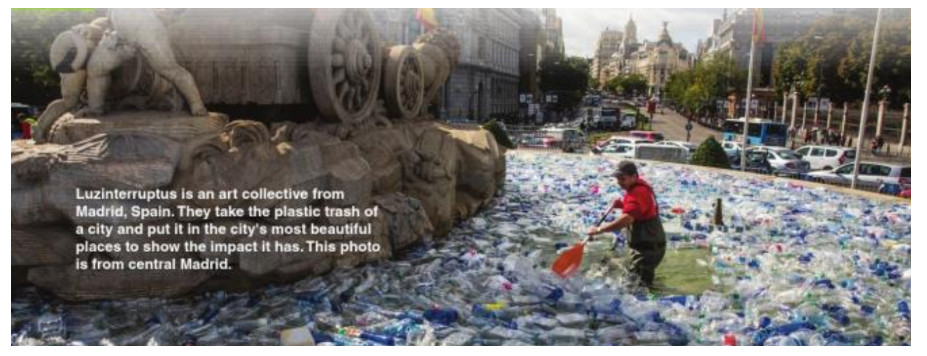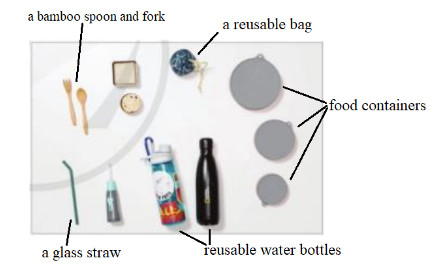Tiếng Anh 10 Unit 12 12B
A. Look at the photo. Is this a problem in your country? How can we solve the problem? B. You are going to listen to a podcast about Marie McGory. She packed these items for a trip to Belize. Match the words to the pictures. C. Listen and circle T for true or F for false. D. Listen and write the missing verbs in the conditional sentences. E. Listen to the sentences in D again. Draw arrows to show rise and fall intonation. GOAL CHECK - Choose What to Use
Tổng hợp đề thi học kì 1 lớp 10 tất cả các môn - Cánh diều
Toán - Văn - Anh - Lí - Hóa - Sinh - Sử - Địa...
A
Listening (Nghe)
A. Look at the photo. Is this a problem in your country? How can we solve the problem?
(Nhìn vào bức hình. Đây có phải là một vấn đề ở đất nước của bạn không? Làm thế nào chúng ta có thể giải quyết vấn đề này?)

Lời giải chi tiết:
- Yes, it’s also a problem in my country. We can solve it by stopping using plastic and encouraging people to use environmentally friendly materials.
(Vâng, đó cũng là một vấn đề ở đất nước tôi. Chúng ta có thể giải quyết bằng cách ngừng sử dụng nhựa và khuyến khích mọi người sử dụng các vật liệu thân thiện với môi trường.)
B
B. You are going to listen to a podcast about Marie McGory. She packed these items for a trip to Belize. Match the words to the pictures.
(Bạn sẽ nghe một podcast về Marie McGory. Cô ấy đóng gói những thứ này cho một chuyến đi đến Belize. Nối các từ với hình ảnh tương ứng.)

Phương pháp giải:
- a bamboo spoon and fork: thìa và dĩa tre
- food containers: hộp đựng thực phẩm
- a glass straw: ống hút thuỷ tinh
- a reusable bag: túi tái sử dụng
- reusable water bottles: chai nước tái sử dụng
Lời giải chi tiết:

C
Vocabulary (Từ vựng)
C. Listen and circle T for true or F for false.
(Nghe và khoanh tròn vào chữ T cho câu đúng hoặc F cho câu sai.)
| 1. Humans produce about 450 million tons of plastic a year. | T | F |
| 2. A lot of plastic is in oceans and on beaches. | T | F |
| 3. Everyone is trying to stop using single-use plastic. | T | F |
| 4. Marie tried to travel without using single-use plastic. | T | F |
| 5. With a food container, one won't have to buy fast food in plastic. | T | F |
| 6. Marie did a lot of planning before her trip. | T | F |
| 7. Not using single-use plastic is expensive. | T | F |
Lời giải chi tiết:
1. Humans produce about 450 million tons of plastic a year.
(Con người sản xuất khoảng 450 triệu tấn nhựa mỗi năm.)
2. A lot of plastic is in oceans and on beaches.
(Có rất nhiều nhựa trong các đại dương và trên các bãi biển.)
3. Everyone is trying to stop using single-use plastic.
(Mọi người đang cố gắng ngừng sử dụng đồ nhựa dùng một lần.)
4. Marie tried to travel without using single-use plastic.
(Marie đã cố gắng đi du lịch mà không sử dụng đồ nhựa dùng một lần.)
5. With a food container, one won't have to buy fast food in plastic.
(Với hộp đựng thức ăn, người ta sẽ không phải mua thức ăn nhanh đựng trong túi nhựa.)
6. Marie did a lot of planning before her trip.
(Marie đã lên kế hoạch rất nhiều trước chuyến đi.)
7. Not using single-use plastic is expensive.
(Không sử dụng nhựa dùng một lần là tốn kém.)
D
D. Listen and write the missing verbs in the conditional sentences.
(Nghe và viết các động từ còn thiếu trong các câu điều kiện sau.)
1. If we _____ using single-use plastic, we _____ the problem.
2. If you _____ two water bottles, it _____ enough water for a long trip.
3. If you _____ food containers, you _____ fast food in plastic.
4. If you _____ to a cafe and _____ a drink, _____ the waiter that you don't need a plastic straw.
E
E. Listen to the sentences in D again. Draw arrows to show rise and fall intonation.
(Nghe lại các câu trong bài D. Vẽ mũi tên để thể hiện ngữ điệu tăng và giảm.)

(Nếu chúng ta ngừng sử dụng đồ nhựa dùng một lần, chúng ta sẽ giải quyết được vấn đề.)
Goal check
GOAL CHECK - Choose What to Use
(Kiểm tra mục tiêu – Chọn những Thứ để Sử dụng)
1. In groups, think about the last 24 hours. Fill in the first column of the table. Write the plastic items you used.
(Hoạt động theo nhóm, hãy nghĩ về 24 giờ qua. Điền vào cột đầu tiên của bảng. Viết các vật dụng bằng nhựa mà bạn đã sử dụng.)
2. Which items were single-use plastic? Which were reusable? Check (✓) the correct column.
(Những thứ nào là đồ nhựa sử dụng một lần? Cái nào có thể tái sử dụng? Đánh dấu (✓) vào cột đúng.)
3. Among the single-use plastic items in the table, which can you avoid using? How?
(Trong số những đồ nhựa dùng một lần trên bàn, bạn có thể tránh sử dụng cái nào? Bằng cách nào?)
4. Join another group and tell them about your choices.
(Tham gia nhóm khác và nói với họ về lựa chọn của bạn.)
|
Plastic Item (Đồ Nhựa) |
Single-Use? (Dùng một lần?) |
Reusable? (Tái sử dụng được?) |
A: If I need a bag. I won't use a plastic one. I can use a paper bag.
(Nếu tôi cần một cái túi. Tôi sẽ không sử dụng túi nhựa. Tôi có thể sử dụng túi giấy.)
B: If I pack a lunch, I can use a reusable food container.
(Nếu tôi gói bữa trưa, tôi có thể sử dụng hộp đựng thức ăn có thể tái sử dụng được.)
Lời giải chi tiết:
|
Plastic Item (Đồ vật Nhựa) |
Single-Use? (Dùng một lần?) |
Reusable? (Tái sử dụng được?) |
| Bottles of water (Chai nước) | ✔ | |
| Plastic straws (Ống hút nhựa) | ✔ | |
| Plastic spoons (Thìa nhựa) | ✔ | |
| Plastic bags (Túi nhựa) | ✔ | |
| Cups and dishes (Cốc và đĩa) | ✔ |
A: If I need a bag. I won't use a plastic one. I can use a cloth bag.
(Nếu tôi cần một cái túi. Tôi sẽ không sử dụng túi nhựa. Tôi có thể sử dụng túi vải.)
A: If I need spoons, I can use wood spoons.
(Nếu tôi cần thìa, tôi có thể sử dụng thìa gỗ.)
A: If I drink milk, I can use paper straws.
(Nếu tôi uống sữa, tôi có thể sử dụng ống hút giấy.)












